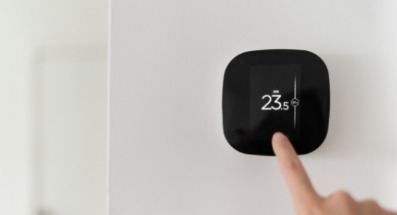How To Fix Amazon Thermostat Not Connecting To Wifi?
Amazon Thermostat is a smart device designed for people who are willing to operate or manage their HVAC system. Being a smart device, Amazon Thermostat is also lacking at some points.
Several users have complained about the connectivity issue of this device. If you are among the users whose Amazon Thermostat not connecting to Wifi and looking for a proper solution, then this guide is for you. In this guide, we have brought you the different ways using which you can get rid of this issue.
Factors that are contributing to the "Amazon Thermostat not connecting to Wifi" issue
- Unstable Wifi signals
- Router issues
- Outdated firmware
- Temprory technical glitch in your device.
Pre-Requisite to Connecting the Thermostat to WiFi
The below criteria must be fulfilled at your end before connecting the thermostat to Wifi
- Your smart device must be up-to-date
- Your smart device must be in the network range
- The Wifi signals must be stable or the network must be uninterrupted.
Troubleshooting Methods Suggested to Get Rid of this Issue.
We have brought you effective solutions in this guide that you can use to get rid of your Thermostat connectivity issue. Have a look at these troubleshooting solutions one by one below:

1. Try Restarting Your Router.
Sometimes a technical glitch causing the connectivity issue might get resolved by just restarting your network device. To restart your Router adhere to the below instructions.
Step 1: Power Off or Unplug your router
Step 2: Wait for 1-2 minutes
Step 3: Reconnect and power on your router and let it sit completely to boot up, once your router connectivity lights are stable, check if the issue gets resolved.
2. Try Restarting your Thermostat.
Adhere below steps to restart your amazon smart thermostat.
Step 1: Sofly take-out the faceplate from the wall
Step 2: Wait for 7-10 seconds
Step 3: Reconnect the faceplate and check if the issue is resolved.
3. Try Checking the Firmware of Your Smart Device.
Sometimes your outdated firmware might be the reason behind this issue. You must be sure that the firmware of your device must be up-to-date.
Adhere to the below instructions to check for firmware updates on your Amazon Thermostat.
Step 1: Reach out to the "Quick menu" on your thermostat
Step 2: Select "Settings"
Step 3: Tap "Software update"
Step 4: Check for updates and update your device
Step 5: Check if the issue gets resolved.
4. Try Connecting your Thermostat with the Right Frequency.
Connecting or pairing your thermostat with the right frequency is the most important thing to consider while configuring your device.
Note: Amazon Thermostat only supports 802.11 b/g/n at 2.4 GHz. It does not support connecting to your peer-to-peer wifi networks or Ad-hoc networks.
Verify the pairing of your network with the Thermostat device by adhering to the below instructions.
Step 1: Check for your router at your end. it must broadcasts both 5G Wifi and 2.4 GHz
Step 2: Take out your phone and "Scan" for the Wifi signals. Verify if there is 5G at your end
Step 3: "Connect" your network devices like TV, phone, laptop, etc. to the 5G connection
Step 4: Once "Verified" connect your smart device "Thermostat" to 2.4 GHz and start using it.
5. Try Using a Compatible Encryption Method like WPA or WPA 2.
The users of Amazon Thermostat must be assured of the network encryption method they are using must be compatible with their Thermostat device.
Adhere to the below instructions to check or change your network encryption type.
Step 1: Login into your router dashboard with your credentials on your web browser
Step 2: Look out for "Network configuration menu"
Step 3: Go to and pick "Wireless security"
Step 4: Choose "WPA or WPA 2"
Step 5: Hit Save to apply altered settings.
Summing up:
In this article, we have tried our best to elaborate on all the possible troubleshooting methods to help users to get rid of the "Amazon Thermostat Not Connecting To Wifi?" issue.
Most of the Thermostat users have complained about connectivity issues and we really hope that the troubleshooting methods discussed in this article might be the right solutions they are looking for.
 Published by: Blaze
Published by: Blaze Brand: Amazon Fire Stick
Brand: Amazon Fire Stick Last Update: 10 months ago
Last Update: 10 months ago
 Related Blogs
Related Blogs
How to Connect Alexa With FireStick?
How to Reset a Amazon Fire Stick?
How to Use the Amazon Fire TV Stick?
Why is My Fire Stick Disconnecting From WiFi?
Why does My Amazon Fire Stick Keeps Restarting?

Trending Searches
-
How To Setup WiFi On Samsung Refrigerators? 16 Oct, 24
-
How to Fix Hikvision Error Code 153? - 2025 27 Aug, 24
-
Fix Shark Robot Vacuum Error 9 Easily (How) 29 Nov, 24
-
How to Set up Arlo Camera? 16 Feb, 24
-
How to Reset Honeywell Thermostat WiFi? 07 Mar, 24

Recent Post
-
How to Install Kodi on Amazon Fire Stick? 18 Dec, 24
-
How to Connect Govee Lights to Alexa? 17 Dec, 24
-
How to Connect Kasa Camera to WiFi? 17 Dec, 24
-
How to Fix Eero Blinking White Problem? 16 Dec, 24
-
How to Reset Eero? 16 Dec, 24
-
Why is My ADT Camera Not Working? 15 Dec, 24
-
Merkury Camera Wont Reset? Fix it 14 Dec, 24
-
How to Connect Blink Camera to Wifi? 14 Dec, 24
Top Searches in amazon fire stick